
Walter Philip Reuther was an American leader of organized labor and civil rights activist who built the United Automobile Workers (UAW) into one of the most progressive labor unions in American history. He saw labor movements not as narrow special interest groups but as instruments to advance social justice and human rights in democratic societies. He leveraged the UAW's resources and influence to advocate for workers' rights, civil rights, women's rights, universal health care, public education, affordable housing, environmental stewardship and nuclear nonproliferation around the world. He believed in Swedish-style social democracy and societal change through nonviolent civil disobedience. He cofounded the AFL-CIO in 1955 with George Meany. He survived two attempted assassinations, including one at home where he was struck by a 12-gauge shotgun blast fired through his kitchen window. He was the fourth and longest serving president of the UAW, serving from 1946 until his death in 1970.

The 1936–1937 Flint sit-down strike, also known as the General Motors sit-down strike, or the great GM sit-down strike, was a sitdown strike at the General Motors plant in Flint, Michigan, United States. It changed the United Automobile Workers (UAW) from a collection of isolated local unions on the fringes of the industry into a major labor union, and led to the unionization of the domestic automobile industry.

The United Auto Workers (UAW), fully named International Union, United Automobile, Aerospace and Agricultural Implement Workers of America, is an American labor union that represents workers in the United States and southern Ontario, Canada. It was founded as part of the Congress of Industrial Organizations (CIO) in the 1930s and grew rapidly from 1936 to the 1950s. The union played a major role in the liberal wing of the Democratic Party under the leadership of Walter Reuther. It was known for gaining high wages and pensions for automotive manufacturing workers, but it was unable to unionize auto plants built by foreign-based car makers in the South after the 1970s, and it went into a steady decline in membership; reasons for this included increased automation, decreased use of labor, mismanagement, movements of manufacturing, and increased globalization.
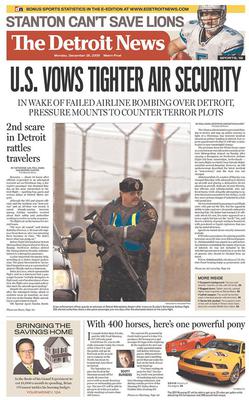
The Detroit News is one of the two major newspapers in the U.S. city of Detroit, Michigan. The paper began in 1873, when it rented space in the rival Detroit Free Press's building. The News absorbed the Detroit Tribune on February 1, 1919, the Detroit Journal on July 21, 1922, and on November 7, 1960, it bought and closed the faltering Detroit Times. However, it retained the Times building, which it used as a printing plant until 1975, when a new facility opened in Sterling Heights. The Times building was demolished in 1978. The street in downtown Detroit where the Times building once stood is still called "Times Square." The Evening News Association, owner of The News, merged with Gannett in 1985.
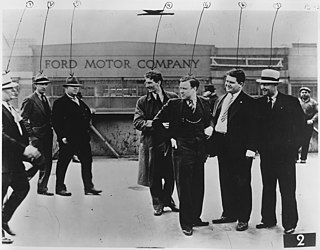
The Battle of the Overpass was an attack by Ford Motor Company against the United Auto Workers (UAW) on May 26, 1937, at the River Rouge complex in Dearborn, Michigan. The UAW had recently organized workers at Ford's competitors, and planned to hand out leaflets at an overpass leading to the plant's main gate in view of many of the 90,000 employees. Before the UAW organizers could begin, they were attacked by Ford's "quasi-military" security service and the Dearborn police.
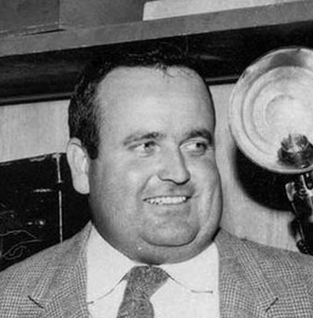
John Lyndon Gaunt also known as Jack was an American photographer who worked for the Los Angeles Times. He won the 1955 Pulitzer Prize for Photography for his photograph titled "Tragedy by the Sea". The image showed a man and a woman standing on a beach after their 19-month-old son disappeared.
The Pulitzer Prizes for 1981 were announced on April 13, 1981.
The following are the Pulitzer Prizes for 1942.

Stanley Joseph Forman is an American photojournalist, who won the Pulitzer Prize for Spot News Photography two years in a row while working at the Boston Herald American.

The 99-day Ford strike of 1945 took place in Windsor, Ontario, Canada, from September 12, 1945, to December 19, 1945. Although several union demands were contentious issues, the two main demands of the UAW Local 200 were "union shop and checkoff," which became a rallying cry for the strikers. Negotiations for a new contract had spanned 18 months and officially ended with the exodus of Ford workers at 10 a.m. on the morning of September 12. The strike included picketing and eventually led to a two-day blockade of vehicles surrounding the Ford plant on November 5.
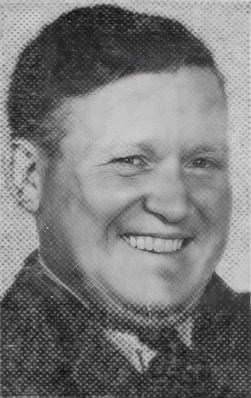
Milton E. "Pete" Brooks was the winner of the first Pulitzer Prize for Photography in 1942.

Leon E. Bates Sr. was an American labor union leader with the United Auto Workers union (UAW) from 1937 to 1964 when he retired as an "International Representative" of the UAW. He was one of the first African-American union organizers to work for the "UAW-CIO".
Stephen Phillip Yokich was an American labor union activist who served as President of the United Auto Workers from 1994 to 2002.
The tool and die strike of 1939, also known as the "strategy strike", was an ultimately successful attempt by the United Auto Workers Union (UAW) to be recognized as the sole representative for General Motors workers. In addition to representation rights, the UAW, working jointly with the Congress of Industrial Organizations (CIO), sought to resolve existing grievances of skilled workers.
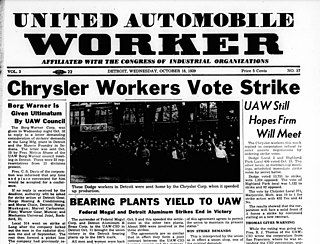
The Chrysler Auto Strike began in October 1939 at the Dodge Main Plant in Detroit, Michigan, as a struggle between the Chrysler Auto manufacturer and the International Union, United Automobile, Aerospace and Agricultural Implement Workers of America, better known as the United Auto Workers (UAW).
The 2021 Virginia Volvo Trucks strike was a labor strike involving workers at a Volvo Trucks production facility in Dublin, Virginia, United States. The strike began in April and ended in July with the ratification of a new labor contract.
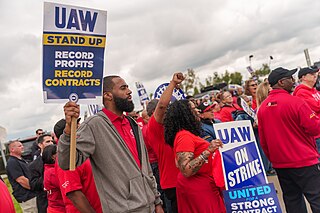
The 2023 United Auto Workers strike was a labor strike involving automobile workers in the labor union United Auto Workers (UAW) and the three unionized automakers in the United States—Ford Motor Company, General Motors, and Stellantis. These three automakers' factories combined employ about 145,000 UAW members and produce about 50 percent of the vehicles manufactured annually in the US, accounting for 1.5 percent of US GDP. The strike began on September 15, 2023, when the union was unable to reach a deal with the three automakers. It was the first trilateral strike against the three automakers in the union's history.

William C. Beall was an American Pulitzer-winning photographer. In 1957 he captured a photograph of two-year-old Allan Weaver and police officer Maurice Cullinane which he titled Faith and Confidence. The image won the 1958 Pulitzer Prize for Photography.
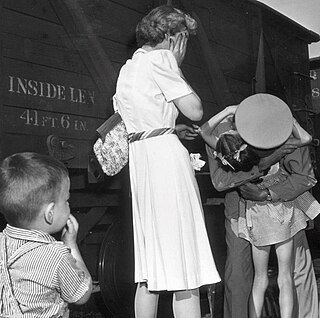
Homecoming is a 1943 photograph of an American soldier returning from active service in World War II. The image was captured by Earle Bunker and it won the 1944 Pulitzer Prize for Photography. The image also won a national Associated Press news photo contest and it was featured in Life, Time and Newsweek.
Shelton Tappes was an American labor organizer and civil rights activist, known for his role in drafting and negotiating the anti-discrimination clause included in the first contract between Ford Motor Company and the United Auto Workers (UAW.)
















